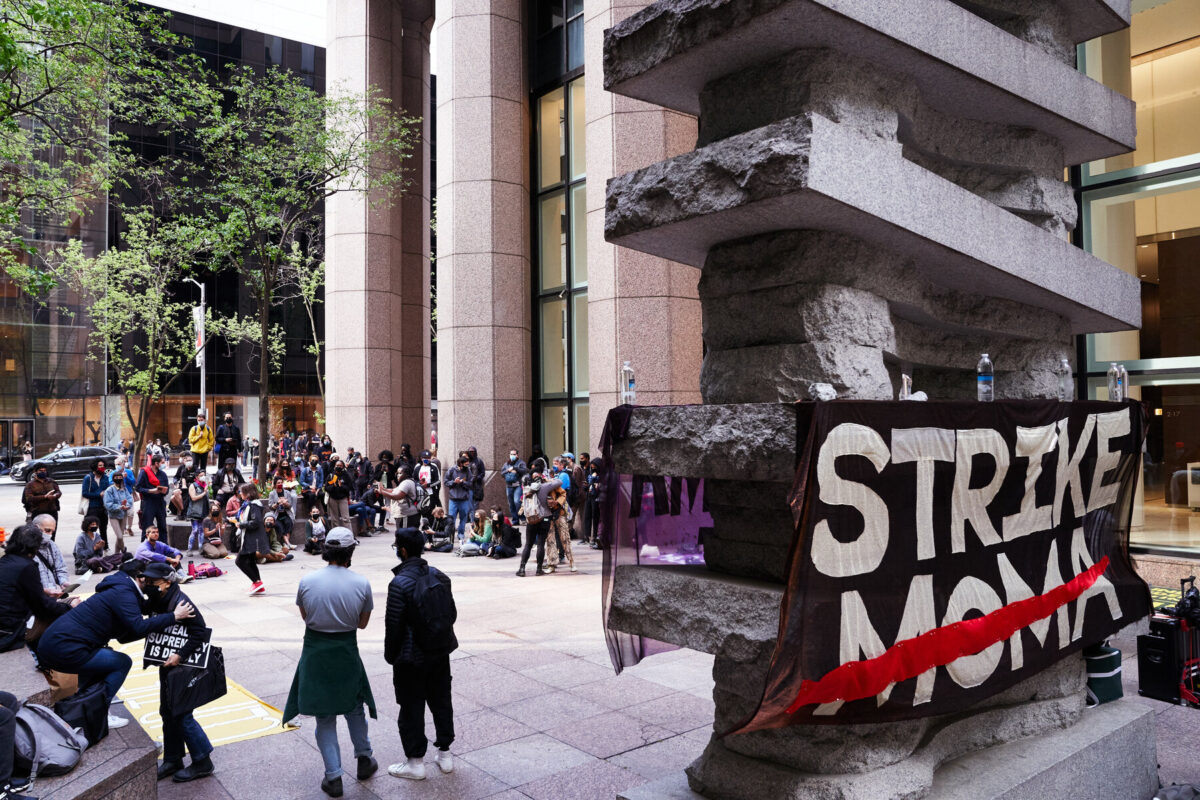By Sara Foster
The first week of April 2020 marked the beginning of the Strike MoMA advocacy campaign, organized by a coalition of activist groups going under the name “International Imagination of Anti-National Anti-Imperialist Feelings”, or IIAAF. At the centre of the 10-week protest campaign is the controversial culture of private philanthropy, in particular donors with questionable intentions and immoral connections, such as Leon Black, a board member of the MoMA who recently succumbed to a chorus of calls for his resignation following the revelation of his financial ties to convicted sex offender Jeffrey Epstein.
Envisioning a “post-MoMA future”, Strike MoMA advocates for a deconstructed, sociable, community-based conception of the museum in opposition to its current dependence on billionaire donors, a structure which contributes to the capture of not only MoMA, but a host of top American museums, by society’s most wealthy.
On April 30, a protest walking tour lead by the advocacy group attracted international attention when it ended in a clash at the MoMA entrance with museum security, and in the aftermath has resulted in an ongoing battle of conflicting accounts offered by IIAAF and MoMA respectively. In the late afternoon around 45 people gathered in Midtown Manhattan’s Columbus Square to participate in a “Ruins of Modernity Tour”, a demonstration making up the fourth part of the Strike MoMA program. The route included a stop at the BlackRock headquarters, the investment company of MoMA trustee Larry Fink, before moving on to “Billionaire’s Row”, a set of eight ultra-luxury residential skyscrapers lining the south end of Central Park.
The final stop was to be the MoMA, where the protestors would occupy the lobby. A week prior, IIAAF had notified MoMA director Glenn Lowry of the group’s intention to enter the museum, demanding free entry (in contrast to the regular immoderate charge of $25 per general ticket). The group received no response and was met upon arrival to the museum entrance by a number of security personal blocking their entry – with doors locked and staff members looking on from the inside – on instructions from museum leadership.
In an email to news outlet Hyperallergic, the group said that contrary to their expectations, the museum “turned itself into an aggressive high-security fortress” to keep them out, typical of Manhattan’s ultra-wealthy enclaves. Amidst the confrontation, four activists broke through a staff entrance on the side of the building to enter the museum. Artist and educator Shellyne Rodriguez (a leading affiliate of Strike MoMA who worked in the MoMA’s education sector for eight years before its recent series of layoffs) reported she had been struck in the face multiple times by a security guard.
Two weeks prior to the demonstration, Lowry wrote to his staff in a recently leaked email that “MoMA respects the right to protest”. Following the incident, the museum provided a statement claiming protesters had tried to “force their entry, en masse, into the museum”, exhibiting “complete disregard for the safety and wellbeing of [its] staff and visitors”, while citing the group’s refusal to comply with Covid-19 health and safety regulations. “We anticipated a peaceful protest”, said a MoMA representative, asserting that two security officers had sustained serious injuries from the altercations. IIAAF refuted this claim in a public statement of their own, condemning “MoMA leadership’s attempt to distort the nature of the confrontation at the museum” and dubbing Lowry “gaslighter-in-chief”.
When the group was unable to gain access to the museum as intended, the demonstration was continued in a plaza opposite the MoMA, where Strike MoMA will continue to meet. A plaque made by the collective Artists for a Post-MoMA Future was installed in the space, reading “This is not an artwork. This is a de-occupation of privately-owned public space.”
The motivations behind Strike MoMA get to the heart of a vital concern circling cultural institutions and the role of large museums. Relative to their European equivalents, US museums receive very little government funding, thus making their income solely reliant on exorbitant ticket prices and patronage from the country’s ultra-wealthy. The system leads to troubling consequences for the art world: art only accessible to those with the funds to view it, collections safeguarded by billionaires and financed with dirty money, museum professionals at the behest of those with potentially self-interested and malevolent motives, and cultural spaces that are meant to be public becoming increasingly exclusive.
“It’s time to put an end to this hypocrisy,” IIAAF’s statement continued. “Too many in our arts communities have learned to turn a blind eye to the gruesome capture of the art world by financial high-rollers with low morals. It’s not too late to stop the plunder, and remember, the fish rots from the head down.”
The remaining Strike MoMA demonstrations will take place every Friday until June 11.

